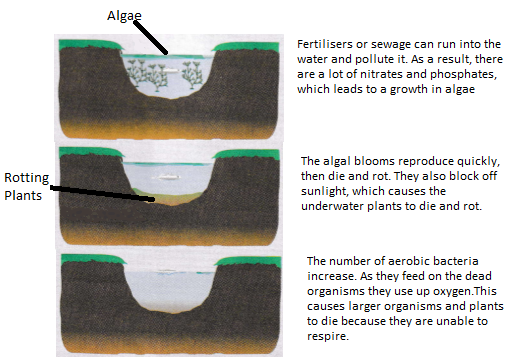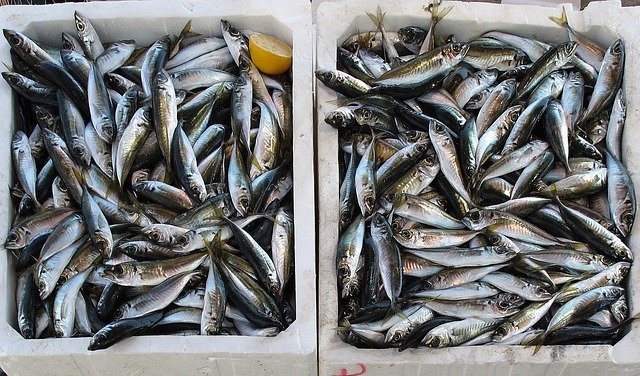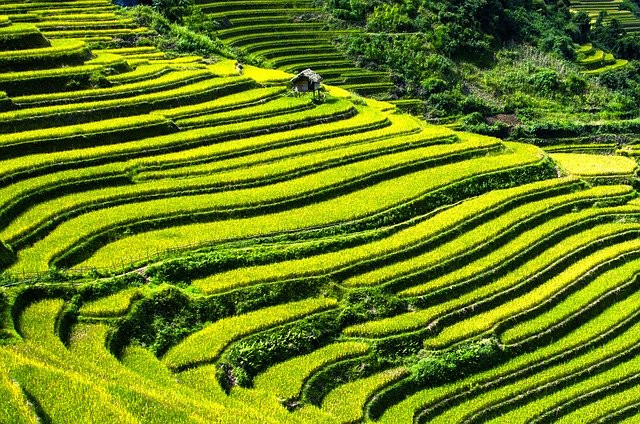Farming and food security
Farming techniques
Intensive farming is characterised by the use of mechanised planting and harvesting and the extensive use of inorganic fertilisers, pesticides and herbicides. These methods are used to achieve high yields.
In order to maximise profits, food production efficiency is the priority. This is achieved by restricting energy transfer from animals to the environment (keeping animals under cover for example) and by limiting the movement of the animals as well as controlling the temperature of the animals surroundings.
This type of farming includes putting battery chickens and calves in cages or pens. Fish can also be grown in cages and feed high-protein diets. Many people object to these farming methods because they think animal welfare is not given a high enough priority.
Eutrophication
Overusing fertilisers in intensive farming can lead to eutrophication.

Food security
As the World’s population continues to increase, food security is becoming an ever more important issue. Food security recognises the importance of allowing everyone on earth to have an adequate diet. Diets in many countries such as China are changing as standards of living increase. So called western diets which have higher red meat content are becoming more common across the World, this in turn is leading to an increase in demand for more land to be devoted to livestock production.
Many factors need to be taken into account when trying to achieve food security:
- The cost of farming methods continues to rise, potentially pushing up the price of food.
- Climate change means that some countries are deprived of rainfall, while others suffer flooding, both scenarios will lead to crop failure. This in turn leads to widespread famine and armed conflict as populations migrate to find work and food.
- Due to a massive increase in the use of pesticides, new pests will develop that are resistant to existing chemicals. Pathogenic microorganisms will also evolve to become resistant to methods of control such as antibiotics.
- Many developed countries and increasingly developing countries have a demand for scarce food resources, meaning that some foods are transported many thousands of miles from their point of origin.
Future solutions to improve food security might include:
- The increased use of hydroponics, this method involves growing plants without the need for soil under very controlled conditions.
- The increased use of biological control, this method uses natural invertebrates as predators to control pests.
- Gene therapy, making more crops pest resistant (GM Crops), although this is very controversial in some parts of the World.
- Increased use of pesticides and fertilisers.
Sustainable fishing

Due to past over fishing, fish stock across the World are in decline. For some fish species such as northwest Atlantic cod, the problem is so severe that unless methods are used to halt the decline they will become extinct.
Sustainable fishing controls include:
- Governments imposing quotas that limit the species and weight of fish that can be taken from the oceans on a yearly basis.
- Increasing the mesh size on fishing nets to allow smaller fish to escape and reach adulthood so they can breed.
Biotechnology
Biotechnology, including genetic engineering has allowed new food substances to be produced relatively cheaply. Microorganisms can be grown in large vats.
Mycoprotein can be produced using fungus, fusarium, which is protein rich and suitable for vegans. The fungus is grown in glucose syrup in aerobic conditions in a matter of days. Once grown the biomass is harvested and purified.
GM crops can be used to increase crop yields and add nutritional value by increasing the vitamin content of crops such as golden rice.

The video below looks at different types of agricultural activity.
